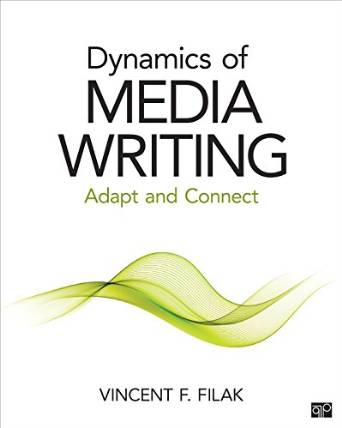Book finds common ground among writing styles for print, web, promotions, advertising and marketing
By Lindsey Wotanis
Marywood University
Anyone who has taught a required basic news writing and reporting course that serves as a core requirement for all communication majors—from journalism students to those in public relations, advertising, marketing, or even film—has likely heard the familiar groan, which is usually followed by a question like:
 “Why do I need to take a news writing course if I’m studying for a career in marketing?”
“Why do I need to take a news writing course if I’m studying for a career in marketing?”
The answer: Because in order to work well with others and achieve specific writing goals, media professionals need to understand the style and mission of their colleagues’ writing goals.
Beginning students often just don’t get it, but media writing teachers like Vince Filak do. Filak must have been sick of explaining this notion to students—and sick of hearing his colleagues groan about all the groaning—because he’s just published a new textbook called “Dynamics of Media Writing: Adapt and Connect” from CQ Press which is likely to help alleviate the frustration.
As he says in the book’s forward, “The way we approach media writing in this book is about finding common ground among the disciplines.” This is a fresh approach that’s long overdue.
The fundamentals of media writing often are taught to students via an introductory news writing class. Many curriculums create a sense of “otherness” by segmenting students into curricular silos, highlighting differences in the field rather than similarities.
Dynamics of Media Writing aims to flip the script. The book is organized to focus on the commonalities among media writing styles first before diverging into more specialized styles in the second half. Topics traditionally found at the end of news writing texts, like sections on writing for the web, or law and ethics, are moved forward to emphasize the transferability of the concepts and skills for all media writers.
The first half of the book includes the staples of traditional news writing textbooks: active voice, tight writing, accuracy, and news values. In the case of the latter, though, Filak makes an important change. Instead of news values, Filak describes audience “interest elements.” This may seem like a simple, semantic difference, but citing interest elements, rather than news values, could help reframe the way students view news writing and understand how it is applicable to their individual career goals—hence, alleviating the groaning.
The second half of the book presents an even mix of emphasis on writing for news as well as writing for promotion. The segment on news focuses on writing for print, broadcast, and web, while the segment on promotion and publicity focuses on writing for public relations, advertising, and marketing—something rarely given such attention in traditional news writing textbooks.
Additional features such as the “Adapt” boxes highlight commonalities among the writing disciplines, demonstrating to readers that concepts from news writing can be applied, for example, in public relations writing and vice versa. “Connect” boxes help keep the readers focused on audience and how writing decisions ultimately impact the way readers consume and understand media writing.
Filak has also called on a number of experienced media writing professionals who offer readers their personal take on a variety of concepts in sections called “Professional Thoughts.” These sections conclude with the professionals offering their most important pieces of advice based on their experiences in the industry. It’s invaluable for students to hear from those working in the field, and these sections lend credibility and salience to the skills covered in the chapters.
Filak also provides instructors with additional downloadable resources via the publisher’s website. Those resources include test banks and PowerPoints for every chapter, as well as extra video and multimedia resources that can be used to supplement course material. Also provided are course cartridges compatible with Moodle, Blackboard and other learning management systems.
Those using traditional news writing and reporting textbooks for the basic media writing course might miss some features they have grown accustomed to, including numerous writing exercises for students to complete in or out of class. Though the “Write Now” sections at the end of each chapter provide readers with options for reflecting on concepts, the text lacks more practical types of writing exercises. As a result, adopters may wish to supplement with exercises that will allow students to practice specific writing skills or styles.
But, that small critique aside, Filak has provided a timely and useful text for the introductory media writing course. This book has a lot of potential to reframe the way instructors approach the basic writing course and the way students understand the skills as essential to their learning.

Lindsey Wotanis, Ph.D., is an associate professor of communication arts and director of the broadcast journalism program at Marywood University, a private Catholic institution in Scranton, Pa. She serves as co-adviser to the student-run newspaper, The Wood Word, which is making the transition to web-only this January. Since she became a co-adviser in 2010, the newspaper staff has won 23 national awards. She currently serves as Vice President for Communication for the Society for Collegiate Journalists (SCJ), the nation’s oldest organization designed solely to serve college media leaders. She was named SCJ’s Outstanding New Adviser in 2013.
